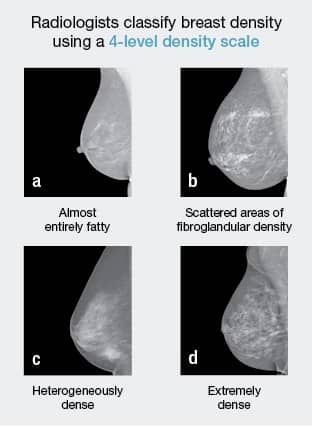While the link between breast density and cancer risk has been long-established, a new study demonstrates that the risk may be even greater than previously known. In a study of more than 200,000 women with breast cancer, breast density was found to be the most prevalent risk factor for both premenopausal and postmenopausal women. It was found to be more prevalent than long-established risk factors including obesity, family history, and giving birth later in life.iii The study results were published earlier this month in JAMA Oncology, which is appropriate timing given that February is cancer prevention month.
The American College of Radiology recommends the use of a system known as the BI-RADS scale to categorize breast density. This scale divides breast density into four categories: A, B, C, and D. “A” means the breasts are almost entirely fatty; “B” means there are scattered areas of fibroglandular density; “C” means the breasts are heterogeneously dense, which may obscure small masses; and “D” means the breasts are extremely dense.iv Younger women tend to have more dense breast tissue; as women age, their breasts tend to become less dense.ii
In a recent studyv, researchers at the Department of Epidemiology and Biostatistics at the University of California, San Francisco (UCSF) found that women whose breasts are predominantly made up of more dense, fibroglandular tissue have higher odds for developing breast cancer than women with fatty breasts.
The research team also assessed a range of other known breast cancer risk factors for participants, including weight, family history of disease, prior history of benign breast lesions, and maternal age to assess the impact of other known risk factors for breast cancer. The team concluded that about 39% of breast cancers in younger, premenopausal participants could have been prevented if their breasts were less dense. Among older, postmenopausal women studied, researchers found about a 26% reduction in breast cancer, using the same calculations.i
Knowing one’s breast density is important, but without the latest technology to standardize these assessments, breast density categorization can be subjective across radiologists. iCAD’s PowerLook Density Assessment, an automated breast density solution, introduces a new level of accuracy and standardization in measurements of breast density. The advanced technology can categorize breast density based on the structure, texture, and dispersion of fibroglandular tissue. One of the key advantages for patients is that more accurate and precise assessments of breast density can help radiologists identify patients who might benefit from additional testing such as ultrasound or MRI. Currently, over 200 sites providing screening mammography services are utilizing PowerLook Density Assessment as their automated density assessment solution.
In honor of cancer prevention month, all of us at iCAD encourage you to get screened for breast cancer and learn more about your breast density and other risk factors. Accurate and reliable breast density assessments can help more women to better understand their individual risks and the possible need for additional screening to detect breast cancer earlier when it may be more easily treated.
About iCAD:
iCAD is a global medical technology leader providing innovative cancer detection and therapy solutions. We work passionately to provide precise, powerful healthcare solutions expertly engineered to optimize operational efficiency, clinician confidence and patient outcomes. iCAD offers a comprehensive range of artificial intelligence and workflow solutions to support rapid and accurate detection of breast and colorectal cancers. For more information, visit www.icadmed.com or www.xoftinc.com.
References:
ii Cancer.org “Breast Density and Your Mammogram Report” https://www.cancer.org/cancer/breast-cancer/screening-tests-and-early-detection/mammograms/breast-density-and-your-mammogram-report.html
iii Engmann NJ, Golmakani MK, Miglioretti DL, Sprague BL, Kerlikowske K, for the Breast Cancer Surveillance Consortium. Population-Attributable Risk Proportion of Clinical Risk Factors for Breast Cancer. JAMA Oncol. Published online February 02, 2017. doi:10.1001/jamaoncol.2016.6326
iv http://www.cancer.org/acs/groups/content/@editorial/documents/document/acspc-039989.pdf
v UCSF.edu“ ‘Dense Breasts’ Eclipse All Other Known Breast Cancer Risk Factors” http://www.ucsf.edu/news/2017/02/405711/dense-breasts-eclipse-all-other-known-breast-cancer-risk-factors
